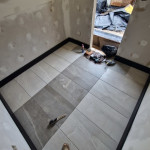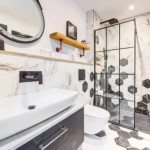
Sjp Plumbing,heating And Gas Services
Location: Stevenage, Hertfordshire
Member Since: 19th Jul 2024
Feedback:
1 reviews, 100% Positive
Trades:
- Bathroom Fitters
About Us:
Hi.
My name is Simon, I have been a plumbing heating and gas engineer for nearly 26 years.
I take immense pride in all aspects of my work and strive to produce a level of excellence that all my customers deserve.
I cover many aspects of the plumbing and heating industry and offering a reliable, professional, hard working fully qualified and insured service to all my clients no matter how big or small your job may be.
I look forward to working with you on your projects and hope to build a long-lasting, trusted working relationship.
Many thanks
Simon James Penketh
My name is Simon, I have been a plumbing heating and gas engineer for nearly 26 years.
I take immense pride in all aspects of my work and strive to produce a level of excellence that all my customers deserve.
I cover many aspects of the plumbing and heating industry and offering a reliable, professional, hard working fully qualified and insured service to all my clients no matter how big or small your job may be.
I look forward to working with you on your projects and hope to build a long-lasting, trusted working relationship.
Many thanks
Simon James Penketh
Feedback:
1 reviews, 100% Positive
Answers:
Your direct unvented cylinder will replenish with cold mains supplied cold water the moment you open any hot outlet tap or valve connected to the system. in simple terms, any cold water introduced to the cylinder will reduce the temperature of the water but hot the cylinder will still hold hotwater at a certain level until it has been consumed.
please bear in mind that depending on your usage, the immersion heater timings and the time the hot water takes to re generate in accordance to the manufacturers instructions the immersion thermostats should automatically start the heating process ( call for heat) once it has detected that the tempreture has dropped below the desired level. the volume of hot water used will ultimately affect the timing of your immersion heaters.
please bear in mind that depending on your usage, the immersion heater timings and the time the hot water takes to re generate in accordance to the manufacturers instructions the immersion thermostats should automatically start the heating process ( call for heat) once it has detected that the tempreture has dropped below the desired level. the volume of hot water used will ultimately affect the timing of your immersion heaters.
Yes! waste pipes can be connected to a soil stack externally as long as the installation is accordance to building and foul water regulations and is installed to meet manufacturers requirements ensuring and outlet no longer is used are safely plugged or capped.
No!
please purchase the correct taps.
by installing the correct taps you will eliminate any leak potentials .
you will also save yourself cost in labour charges and ultimately you will have the desired look you wanted.
please purchase the correct taps.
by installing the correct taps you will eliminate any leak potentials .
you will also save yourself cost in labour charges and ultimately you will have the desired look you wanted.
This will depend on the type of dual shower head you have. if your dual shower os a part of a riser rail assembly with diverted valve or fixed head assemble with fixed hand held and diverted.
either way the process is fairly straightforward
turn off the water supply to the shower. locate the isolatio valve this will depend on the type of system your proerty has and whether there is independent isolation to this appliance. once you have deternined how to isloate and make safe.
unscrew the existing shower heads fixed or on riser rails, ensuring you use the correct tools
ensure you remove or cap off any of the existing shower controls no longer required
assemble and install all components of the new show i'm accordance to the manufacturer's installation requirements and instructions.
be careful not to scratch the shower by using incorrect tools
ensure to use the correct materials ie. ptfe, putty, pastes or silicones to ensure a water tight seal and that also meet the manufacturer's requirements.
test accordingly.
either way the process is fairly straightforward
turn off the water supply to the shower. locate the isolatio valve this will depend on the type of system your proerty has and whether there is independent isolation to this appliance. once you have deternined how to isloate and make safe.
unscrew the existing shower heads fixed or on riser rails, ensuring you use the correct tools
ensure you remove or cap off any of the existing shower controls no longer required
assemble and install all components of the new show i'm accordance to the manufacturer's installation requirements and instructions.
be careful not to scratch the shower by using incorrect tools
ensure to use the correct materials ie. ptfe, putty, pastes or silicones to ensure a water tight seal and that also meet the manufacturer's requirements.
test accordingly.
Yes you can an outside tap can be fitted to pretty much any property, even if the current pipework is not close to where the tap needs to be. it is, of course, an easier job if the water feed is close by especially to the exterior wall you would lime it to be but in this case your options are limited without disruption and expense.
most definitely install an isolation valve before the outlet and ensure that the outside tap has an inbuilt non return valve so to avoid any cross contamination of the mains water supply.
as long as the tap has been installed correctly and is serviceable you can locater the tap in many locations. be aware an outside tap is not very pretty so i suggest you place it wisely over a sink would be great as this will eliminate potentials of dripping etc when your hose is either placed on or off. i hope this helps
most definitely install an isolation valve before the outlet and ensure that the outside tap has an inbuilt non return valve so to avoid any cross contamination of the mains water supply.
as long as the tap has been installed correctly and is serviceable you can locater the tap in many locations. be aware an outside tap is not very pretty so i suggest you place it wisely over a sink would be great as this will eliminate potentials of dripping etc when your hose is either placed on or off. i hope this helps
Other Tradesmen in Stevenage
Would you like a quote from this tradesperson?
Invite them to quote for your job & get a fast response.
- Other tradespeople may express their interest as well.





